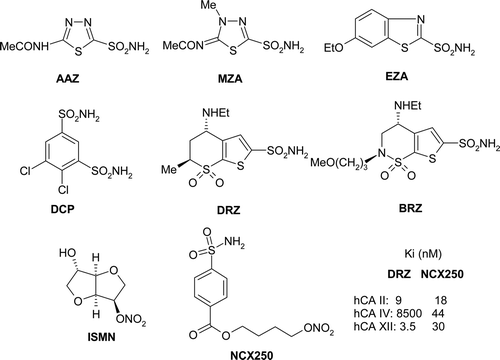Abstract
The clinically used sulfonamide carbonic anhydrase (CA, EC 4.2.1.1) inhibitor dorzolamide (DRZ), a new sulfonamide CA inhibitor also incorporating NO-donating moieties, NCX250, and isosorbide mononitrate (ISMN) (an NO-donating compound with no CA inhibitory properties) were investigated for their intraocular pressure (IOP) lowering effects in rabbits with carbomer-induced glaucoma. NCX250 was more effective than DRZ or ISMN on lowering IOP, increasing ocular hemodynamics, decreasing the inflammatory processes and ocular apoptosis in this animal model of glaucoma. NO participate to the regulation of IOP in glaucoma, having also antiapoptotic and anti-inflammatory effects. The ophthalmic artery, both systolic and diastolic velocities, were significantly reduced in NCX250-treated eyes in comparison to DRZ treated ones, suggesting thus a beneficial effect of NCX250 on the blood supply to the optic nerve. Combining CA inhibition with NO-donating moieties in the same compound offers an excellent approach for the management of glaucoma.
Introduction
Glaucoma is the second leading cause of vision loss worldwide, after retinal degeneration, being estimated that as many as seventy million individuals may suffer from this conditionCitation1,Citation2. Glaucoma involves a progressive optic neuropathy exhibiting characteristic changes of the optic nerve head and visual fields and it is commonly linked to elevated intraocular pressure (IOP). Treatment strategies to prevent glaucoma and the consequent irreversible loss of vision are based on the reduction of IOP by using topical hypotensive drugsCitation1–3. Glaucoma is a term covering a group of ophthalmological disease processes. A common factor to each of the conditions in this group is the occurrence of an optic neuropathy believed to be due in part to elevated IOPCitation1–3. Although different forms of glaucoma are known, the most common condition is adult-onset open chamber-angle glaucoma (“open angle glaucoma” or OAG), which is age related and characterized by an open chamber angle, elevated IOP, a visual field defect and an area of pallor around the cupped optic nerve head, as well as constriction of blood flow through the vasculatureCitation1–3.
Nitric oxide (NO), a radical gas produced by the enzyme nitric oxide synthase (NOS) is involved in aqueous humour outflow within the eye, local modulation of ocular blood flow, and retinal ganglion cells death by apoptosisCitation4–6. It has been observed that hypertensive glaucoma patients have a decreased NO/cGMP content in the aqueous humourCitation3 and that several classes of NO-donors decrease IOP in normal and pathological conditionsCitation4–7.
Sulfonamides acting as inhibitors of the zinc enzyme carbonic anhydrase (CA, EC 4.2.1.1) are clinically used as antiglaucoma agents for decadesCitation8–11. Compounds such as acetazolamide (AAZ), methazolamide (MZA), ethoxzolamide (EZA), or dichlorophenamide (DCP), clinically have been used as systemic antiglaucoma agents for more than 50 yearsCitation8–11. Although glaucoma treatment with CA inhibitors (CAIs) is effective in reducing elevated IOP, systemic administration of these drugs leads to a wide range of side-effects due to inhibition of the enzyme present in other tissues (kidneys, red cells, stomach, lungs, etc.) than the eyeCitation8–11. Indeed, sulfonamides such as those mentioned above, are potent inhibitors of most of the 13 catalytically active CA isoforms described so far in mammalsCitation8. The possibility of the topical administration of classical drugs from this class (AAZ, MZA, EZA, or DCP) was investigated extensively in the 50s and 60s, but negative results have been constantly obtained, and for more than 40 years it was considered that CAIs could only be given systemicallyCitation2,Citation8,Citation12. In the mid 90s the first clinically used, topically effective antiglaucoma sulfonamide, dorzolamide (DRZ), has been discovered, followed shortly thereafter by brizolamide (BRZ), a structurally related to DRZ compoundCitation8,Citation12. No new drugs from this class have been clinically launched in the last 12 yearsCitation2.
Recently we have reported a new class of sulfonamide CAIs also incorporating NO donating moieties of the ester typeCitation7. One of the reported compounds, NCX250, is the ester incorporating NO-donating groups of 4-carboxybenzenesulfonamide and shows interesting IOP lowering effects in hypertensive rabbitsCitation7. In the present study we further focus on the effects of NO-donating molecules with or without CA inhibitory properties of the sulfonamide type on lowering IOP in animal models of glaucoma, on the retrobulbar haemodynamic effects (evaluated by means of Colour Doppler Imaging, CDI), as well as on pharmacological evaluations assessing the mode of action of such compounds, e.g., on the inflammatory cytokine production in aqueous humour and on retinal and neuronal apoptosis prevention. A detailed such study is presented here by comparing the antiglaucoma properties of DRZ, NCX250, and the NO-donating compound isosorbide mononitrate (ISMN). Furthermore, we describe in detail an efficient procedure for inducing elevated IOP in rabbits using carbomer (a high molecular weight polymer of acrylic acid), modifying a reported literature procedure published only in Chinese in 2002Citation13.
Materials and methods
The experiments were carried out with the following compounds: DRZ and ISMN (commercially available from Sigma-Aldrich, Milan, Italy) and NCX250, prepared as reported earlierCitation7. The two sulfonamides were solubilized in phosphate buffer pH 6, supplemented with Cremophor EL 5% and DMSO 0.3%; NCX250; a physiologically acceptable aqueous solution for NCX-250 2% was also obtained with PBS pH 5.5, DMSO 12% (v/v) (120 µl/ml) and cremophor EL 20% (v/v) (200 µl/ml). Cremophor EL (C5135) was purchased from Sigma Aldrich (Milan, Italy). DRZ (0.5-1-2%) and ISMN (0.5-1-2%) were dissolved in PBS pH 5.5 and DMSO 0.3% (v/v) (3 µl/ml).
Animals and glaucoma induction
Adult male New Zealand Albino rabbits weighing 2–2.5 kg were employed in this study. The animals were utilized in groups of eight for each of the chosen specific treatments. The experimental procedures were conform to those of the Declaration of Helsinki and with the Guideline for the Care and Use of Laboratory Animals as adopted and promulgated by the US National Institute of Health, and were conducted upon authorization of the Italian Regulations on Protection of Animals used for experimental and other scientific purpose (DM 116/1992) as well as with the European Union Regulations (OJ of ECL 358/1, 12/12/1986), and the experimental protocol was approved by the local animal care committee of the University of Florence (Florence, Italy). The rabbits were kept in individual cages, food and water were provided ad libitum. The animals were identified with a tattoo on the ear, numbered consecutively and maintained on a 12–12 h light/dark cycle in a temperature controlled room (22°–23°C). All selected animals were examined before the beginning of the study and were determined to be normal on ophthalmic and general examinations. Glaucoma was induced by injection of 0.1 ml 0.25% carbomer (Siccafluid, FarMila–THEA Pharmaceuticals) into anterior eye-chamber bilaterally in New Zealand albino rabbitsCitation13 anesthetized with tiletamine and zolazepam (Zoletil 100, 0.05 mg/kg b.w.) plus xilazine (Xilor 2%, 0.05 ml/kg b.w.) intramuscularlyCitation14.
IOP was measured before carbomer injection and after 1, 2 and 4 h the first day and three times a day until stabilizationCitation15,Citation16 and then every 24 h. All rabbits treated with carbomer presented a net increase in IOP. One drop of 0.2% oxybuprocaine hydrochloride (Novesine, Sandoz) diluted 1:1 with sterile saline was instilled in each eye immediately before each set of pressure measurements.
IOP was measured using a Tono-Pen XL tonometer (Medtronic Solan, Jacksonville, FL) as reported by earlierCitation15,Citation16. The pressure readings were matched with two-point standard pressure measurements every week using a Digilab calibration verifier. All IOP measurements were done by the same investigators (F.F. and F.M.) using the same tonometer.
As soon as a stable IOP increase was obtained, the animals were treated with the drugs in study. The efficacy of the different drugs in lowering IOP was evaluated after drug administration over 4 h, with the following schedule: before and after 30, 60, 90, 120 and 240 min after drug administration. The treatment was performed in four animals per drug in one eye and compared to the contralateral eye treated with vehicle. In some groups of animals, aqueous humour was withdrawn from both the posterior and anterior chamber fluid of each eye before drug administration, and at different times after treatment. The same volume of saline was reintroduced every time. The aqueous humour samples were immediately treated with 3′-isobutyl-1-methylxanthine (IBMX, 10−5 M, 1:10 v/v) to inhibit phosphodiesterase activity, and then frozen at −80°C until use. Other animals were treated with the study drugs for 4 weeks, and aqueous humour was withdrawn, from both eyes of each animal, before treatment and once a week during drug administration. Another group of animals was treated with the study drugs for 4 weeks, without sampling aqueous humour.
A group of 8 non glaucomatous albino rabbits was treated with the drugs of this study and used as control. At the end of the experiments the animals were killed with a lethal dose of Pentothal (Abbott S.p.A., Campoverde di Aprilia, LT) the eyes excised and the ciliary bodies isolated for further determinations.
Evaluation of ocular tolerability
Various schemes have been proposed for grading and scoring the ocular lesions seen in the standard eye irritation test. We followed the scheme proposed by Draize as modified by the US Food and Drug AdministrationCitation17.
Nitrite assay
To measure nitrite and nitrate (NOx) concentrations in the aqueous humour, the samples were treated with nitrate reductase (276 mU/ml) and with 40 μM NADPH+, final concentrations to convert nitrate to nitrite, and their concentrations were determined by the Griess reaction adapted for a 96-well plate reader. In brief, 50 μl of sample were added to 100 μl of Griess reagent (1% sulfanilamide in 5% phosphoric acid and 0.1% N-[1-naphtyl] ethylendiamine). The optical density at a wavelength of 546 nm was measured with a Bio-Rad microplate reader. Nitrite concentrations were calculated by comparison with standard concentrations of NaNO2 dissolved in TRIS, pH 7.5Citation18. The values were expressed as nanomoles per milligram of protein. In parallel, NO concentrations were also determined with a potentiometric NO electrodes (Cristel Instruments, Rome, Italy).
Cyclic GMP and AMP determination
The concentration of cGMP, and cAMP was determined by means of a radioimmunoassay kit using [125I]-labelled cGMP and by an Enzymatic Immunoassay Biotrak™ (EIA) dual range system, respectively (Amersham, Bucks, UK). Five hundred μl of 10% trichloroacetic acid (TCA) were added to the samples, which were then centrifuged and TCA extracted with 0.5 M tri-n-octylamine dissolved in 1,1,2-trichlorotrifluorethaneCitation19. The samples were then acetylated in acetic anhydrideCitation20 and the amount of cGMP and cAMP were measured in the aqueous phase. The values were expressed as femtomoles of cGMP and nanomoles of cAMP per milligram of protein. The protein concentration was determined according to BradfordCitation21.
Colour Doppler imaging evaluations
Retrobulbar hemodynamic evaluations were performed by the same experienced investigator by means of an eco-colour-Doppler DynaView TM II SSD-1700 (Aloka, Tokyo, Japan), using a 6 MHz probe. All the animals underwent CDI investigation of the ophthalmic artery at baseline, at stabilization of the ocular hypertension, and once a week until the end of treatments. Peak-systolic (PSV) and end-diastolic (EDV) velocities were measured, and Pourcelot’s resistivity index (RI) was calculated (RI = PSV−EDV/PSV).
Determination of Prostaglandin E2 and of inflammatory cytokines
Prostaglandin-E2 (PGE2) and inflammatory cytokines (tumour necrosis factor α (TNFα) and interleukin 1β (IL1β)) were determined in aqueous humour, before and after drug treatments, by a colorimetric method, using a commercial ELISA kits (Calbiochem, Novabiochem Corporation, La Jolla, CA) following the instructions of the manufacturer.
Flow cytometric analysis
An Epics XL flow cytometer (Beckman Coulter, Miami, FL) was used for apoptotic cell death analysis. Annexin V-FITC and 7-AAD staining were carried out according to the manufacturer’s protocol (PNIM-3614 Beckman Coulter). Briefly, aqueous humour samples were centrifuged at 1,200 rpm and incubated in 100 µl of binding buffer together with 5 μl of 7-AAD and 5 μl of annexin V-fluorescein isothiocyanate (FITC) for 30 min at room temperature. Annexin V-FITC and 7-AAD fluorescence intensity were measured in FL-1 and FL-3 respectively. The total event number was measured for 6 min in a final volume of 600 µl with a low flow rate, and analysed using Expo32 software (Instruments Laboratories, Milan, Italy). Results were mean of eight independent experiments and data were expressed as percent positive cells. At the end of the experiments the animals were killed with a lethal dose of Pentothal (Abbott S.p.A.) after that, cornea and anterior uvea (iris plus attached ciliary body) were dissected, well rinsed with water, blotted, weighed, and put into 1–2 ml of saline.
CA assay
The ciliary bodies well rinsed with water (and pooled from 4–8 animals) were mechanically homogenised with small glass beads in buffer containing 4-(hydroxyl ethyl)-1-piperazine-ethane-sulphonic acid (HEPES) 0.01 M and tris[hydroxymethyl]aminomethane hydrochloride (TRIZMA hydrochloride) 0.01 M, with Na2SO4 0.1 M adjusted to pH 7.5. The samples were agitated for 2 h and then centrifuged at 12,000 rpm for 15 min and the supernatants were used for the enzymatic determination following the published dataCitation2,Citation6,Citation7. Phenol red was used as indicator (pH 6.8–8.4) at the concentration of 0.02 mM. The CO2 solution was obtained by bubbling CO2 in bidistilled water at 20°C till saturation. The solution obtained in this way was kept in a tightly closed vessel. The reaction rate is followed by the use of phenol red as indicator working at the absorbance of 557 nm, for a period of 1–20 s. The CO2 concentrations ranged from 1.7 to 17 mM for the determination of the inhibition constants (KI)Citation22. The KI was obtained by non-linear least-squares methods using PRISM 3, from Lineweaver–Burk plots, and represent the mean from at least three different determinations for each inhibitor concentrationCitation7,Citation22.
Results and discussion
Carbomer is an insoluble, high molecular weight (>90,000 Da) hydrophilic polymer of acrylic acid, which has the property to absorb and retain water and swallow to many times its original volumeCitation23. It has been reported to function in drug delivery processes of ophthalmologic drugsCitation23 and a report (of which only the abstract is available, as the original publication is in Chinese)Citation13 mentioned about the use of this polymer to induce glaucoma in rabbits. We have thus employed the data of Xu et al.Citation13 to develop a facile procedure to obtain an animal model of glaucoma, by using a water suspension of 0.25% commercially available carbomer, which was injected (a volume of 0.1 mL) into the anterior eye-chamber, bilaterally, in anesthetized New Zealand albino rabbits. High IOP has been developed after several hours post injection and remained high for a long period (). IOP was measured at least twice daily at the beginning of the treatment, and dramatically increased within a few days after carbomer injection into the anterior chamber of both eyes of all rabbits, and remained high (30–55 mm Hg) for the next 4 weeks (). The increase in IOP was concomitant with a significant decrease in nitrites (NO2−) and cyclic nucleotide (cAMP and cGMP) levels in the aqueous humour of treated rabbits ( and ) (n = 20).
Figure 1. Effects of carbomer injection on intraocular pressure (IOP) in a 4 week time course in New Zealand rabbits.
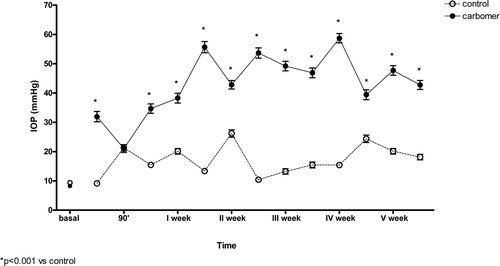
Figure 2. (A) Effects of carbomer injection on nitrite levels in aqueous humour of rabbits, in a 4 week time-course; (B) Effects of carbomer injection on cGMP levels in aqueous humour in a 4 week time-course, in the rabbits used for glaucoma induction.
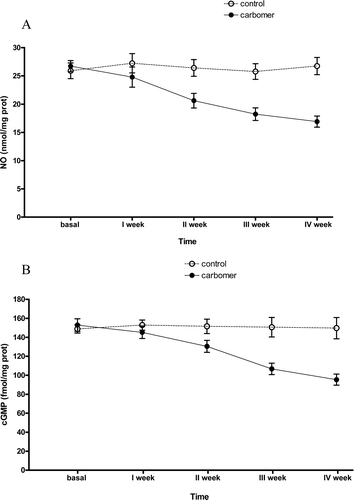
As shown in , the sulfonamide incorporating NO donating moieties NCX250 (which, is a potent inhibitor of CA isoforms involved in aqueous humour secretion, i.e., CA II, IV and XII7) at concentrations of 0.5–2 %, was much more effective than the clinically used compound DRZ in reducing IOP. NCX250 is a potent inhibitor of CA II, IV and XII (KIs of 18–44 nM7), all isoforms involved in aqueous humour secretion within the eyeCitation2,Citation15,Citation16. DRZ is a more potent CA II and XII inhibitor than NCX250 (KIs of 9 and 3.5 nM, respectively), but acts as a rather weak CA IV inhibitor (KI of 8.5 µMCitation10,Citation24). However, the participation of CA IV to the secretion of aqueous humour seems to be limited, whereas CA II plays a significant roleCitation2,Citation10, together with CA XII, which is overexpressed in the eyes of patients with glaucomaCitation25.
Figure 3. Effects of NCX250, at various concentrations (A), of DRZ (at various concentrations, (B) and comparison of NCX250 vs. DRZ 2% (C) on intraocular pressure (IOP) in carbomer-induced glaucoma in albino rabbits.
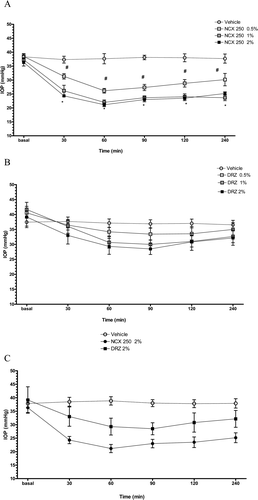
Both these sulfonamides were tested versus vehicle. NCX250 caused a peak in IOP reduction 60 min post-administration, whereas DRZ at 90 min post-administration. NCX250 caused a 35% peak reduction of IOP (n = 4). NCX250 was more effective than DRZ in glaucomatous albino rabbits at all studied concentrations (of 0.5%, 1% and 2%) in lowering IOP (. Both compounds (NCX250 and DRZ), administered at the concentrations of 1 and 2%, evoked a very similar effect on IOP lowering, while at 0.5% concentration they were less effective. Preliminary experiments were also performed to evaluate the tolerability of the various substances in study. NCX250 and DRZ were tested on normotensive rabbits and ocular tolerability was evaluated according to the Draize grade scale as modified by US Food and Drugs Administration. Both compounds were well tolerated with no significant eye irritation observed (data not shown).
Chronic administration of compound NCX250 2% on glaucomatous albino rabbits showed an important reduction in IOP values already after the first week of treatment, with a regular decreasing trend during all treatment period (). This reduction was higher than that observed when ISMN (an NO donor without CA inhibitory activityCitation6,Citation7) or DRZ at 2% were administered. It is thus clear that the important IOP lowering effects observed after treatment with NCX250 is due both to the CA inhibition of this sulfonamide CAI on the aqueous humour formation, and to the NO-mediated effects elicited by this compound (). In order to determine why this occurs, nitrite and cGMP levels were measured once a week during the treatment, being observed that they increased significantly after the second week (). Ocular hemodynamics were evaluated in carbomer-induced glaucomatous rabbits treated with NCX250 in comparison to DRZ. Ophthalmic artery RI registration was lower at the end of treatment in rabbits treated with NCX250 2% in comparison to DRZ 2% treated animals (), demonstrating thus a major efficacy on hemodynamic improvement after treatment with the NO-donating sulfonamide NCX250 compared to DRZ which has only CA inhibitory properties.
Figure 4. Effects of NCX250 2%, DRZ 2% and ISMN 2 % vs. vehicle, on intraocular pressure (IOP), in carbomer-induced glaucoma in albino rabbits in a 4 week time course.

Figure 5. Effect of NCX250 (2%) on cGMP (A) and nitrite (B) levels, in a carbomer-induced glaucoma in albino rabbits in a 4 week time-course.
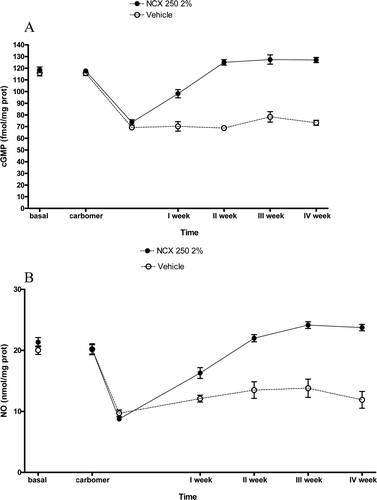
Figure 6. Comparison between the effects of DRZ 2% and NCX250 2% on ocular hemodynamics (eco doppler).
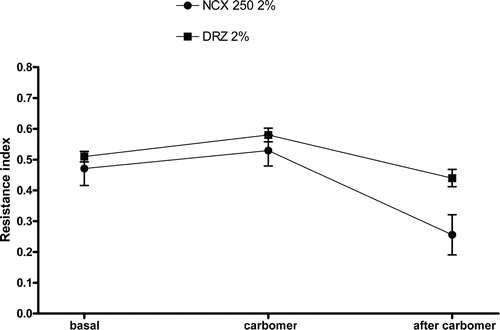
Normotensive albino rabbits were also used to compare the activity of DRZ 2%, ISMN 2% and NCX250 2% in chronic treatment on IOP and apoptosis in aqueous humour. The studied drugs did not show a relevant IOP lowering activity in these animals and did not influence significantly the number of apoptotic cells concentration in aqueous humour of treated animals (data not shown). The three compounds, administered for 4 weeks, demonstrated a similar efficacy in reducing apoptotic cell concentration in aqueous humour in comparison to vehicle treatment ().
Figure 7. Effect of NCX250 (2%), DRZ 2%, ISMN 2% vs. vehicle on apoptotic cell (Annexin V + 7-AAD) and cell concentration in aqueous humour of carbomer-induced glaucoma in albino rabbits.
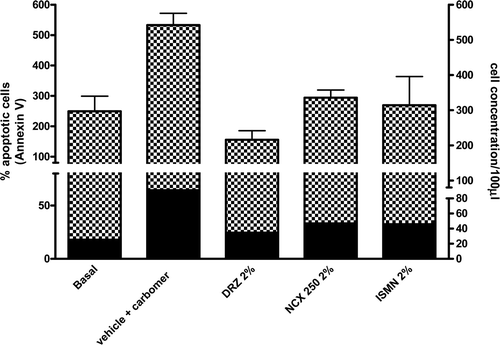
CA activity was strongly augmented in ciliary bodies of carbomer-induced glaucoma in comparison to naïve animals (), suggesting that the strong IOP increase after injection of the carbomer suspension into the eyes of rabbits may be due to the enhancement of the enzyme levels in the eye, by a mechanism which is unknown at this moment. Sulfonamides NCX250 and DRZ at 2% concentration (which are strong CAI in vitro against many eye CAs, see above), administered throughout the 4 weeks period of the treatment, reduced significantly the total CA activity in ciliary bodies, whereas ISMN at the same concentration did not influence the enzyme activity, since this compound is not an in vitro CA inhibitor ().
Table 1. Total carbonic anhydrase (CA) activity in ciliary bodies of rabbits, with or without carbomer-induced glaucoma, and treated with various drugs (NCX250, DRZ, ISMN, at 2%)
Glaucoma is a major global cause of blindness, a uniform definition of the disease is lacking, being thus difficult to assess its public health impact. The results of a specific researchCitation26 demonstrate that glaucoma is responsible for approximately 5.2 million blind (15% of the total burden of world blindness)Citation27. The total number of glaucoma suspects in the world (IOP > 21 mm Hg) is around 105 million persons; congenital glaucoma affects 300,000 children, representing a very small part (1.3%) of the global glaucoma problem but with very high social impact. Globally, primary OAG affects about 13.5 million people over the age of 40 years—this constitutes 60% of the global burden of the diseaseCitation26. The closed angle glaucoma, which has a similar age distribution to that of the open angle form, accounts for 6 million cases (26.6% of the total global burden of glaucoma). The remaining 12.1% of glaucoma is accounted for by 2.7 milion cases of secondary glaucomas caused by other ocular or systemic diseasesCitation26. In Italy, the incidence of glaucoma is approximately 1.5% of the population, but as it is related to the age, if we consider people over 70 years, the incidence is of 6–7%. This trend also applies to the whole of Europe without major changes. The social impact of the disease is as evident as the economic one. The estimated annual costs per patient divided into the main categories related to this disease is estimated at 788.7 euro/year, of which 50 % is represented by the cost of the drugs. If one considers the average incidence of glaucoma in Italy, it can be estimated to be of around 710 million euro (comprising the total social expenditures for the glaucoma disease). However no new drugs against this disease have been discovered in more than 10 years. Thus, the innovative approach we propose here may be crucial for developing novel such agents.
Conclusions
We report here a new approach for obtaining effective and innovative antiglaucoma agents. NCX250, a NO-donating sulfonamide CA inhibitor, was much more effective in lowering IOP than DRZ (a sulfonamide CA inhibitor) or ISMN alone (an NO-donating compound with no CA inhibitory properties). The ophthalmic artery, both systolic and diastolic velocities, were significantly reduced in NCX250-treated eyes in comparison to DRZ treated ones, suggesting thus a beneficial effect of NCX250 on the blood supply to the optic nerve, which is not observed with DRZ. Our results clearly indicate that in carbomer-induced glaucoma, the association of classical anti-glaucomatous agents, such as the sulfonamide CA inhibitor DRZ with NO-donors, augment their effects on lowering IOP, increasing ocular hemodynamic, decreasing the inflammatory processes and ocular apoptosis. In conclusion, our results suggest that not only does NO participate to the regulation of IOP in glaucoma, but it also has an antiapoptotic and anti-inflammatory effects.
Declaration of interest
This study has been financed by NicOx SpA (Milan, Italy).
References
- Quigley HA, Nickells RW, Kerrigan LA, Pease ME, Thibault DJ, Zack DJ. Retinal ganglion cell death in experimental glaucoma and after axotomy occurs by apoptosis. Invest Ophthalmol Vis Sci 1995;36:774–786.
- Mincione F, Scozzafava A, SupuranCT. (2009). Antiglaucoma carbonic anhydrase inhibitors as ophthalomologic drugs. In: Drug Design of Zinc-Enzyme Inhibitors: Functional, Structural, and Disease Applications;, Supuran CT; Winum JY Eds., Wiley, Hoboken (NJ), pp 139–154.
- Galassi F, Masini E, Giambene B, Fabrizi F, Uliva C, Bolla M et al. A topical nitric oxide-releasing dexamethasone derivative: effects on intraocular pressure and ocular haemodynamics in a rabbit glaucoma model. Br j Ophthalmol 2006;90:1414–1419.
- Impagnatiello F, Borghi V, Gale DC, Batugo M, Guzzetta M, Brambilla S et al. A dual acting compound with latanoprost amide and nitric oxide releasing properties, shows ocular hypotensive effects in rabbits and dogs. Exp Eye Res 2011 (Epub ahead of print).
- Krauss AH, Impagnatiello F, Toris CB, Gale DC, Prasanna G, Borghi V et al. Ocular hypotensive activity of BOL-303259-X, a nitric oxide donating Prostaglandin F2a agonist, in preclinical models. Exp Eye Res (In Press).
- Steele RM, Benedini F, Biondi S, Borghi V, Carzaniga L, Impagnatiello F et al. Nitric oxide-donating carbonic anhydrase inhibitors for the treatment of open-angle glaucoma. Bioorg Med Chem Lett 2009;19:6565–6570.
- Mincione F, Benedini F, Biondi S, Cecchi A, Temperini C, Formicola G et al. Synthesis and crystallographic analysis of new sulfonamides incorporating NO-donating moieties with potent antiglaucoma action. Bioorg Med Chem Lett 2011;21:3216–3221.
- Pastorekova S, Parkkila S, Pastorek J, Supuran CT. Carbonic anhydrases: current state of the art, therapeutic applications and future prospects. j Enzyme Inhib Med Chem 2004;19:199–229.
- Supuran CT, Scozzafava A, Casini A. Carbonic anhydrase inhibitors. Med Res Rev 2003;23:146–189.
- Supuran CT. Carbonic anhydrases: novel therapeutic applications for inhibitors and activators. Nat Rev Drug Discov 2008;7:168–181.
- Supuran CT. Carbonic anhydrase inhibitors. Bioorg Med Chem Lett 2010;20:3467–3474.
- Mincione F, Scozzafava A, Supuran CT. The development of topically acting carbonic anhydrase inhibitors as anti-glaucoma agents. Curr Top Med Chem 2007;7:849–854.
- Xu Y, Chen Z, Song J. [A study of experimental carbomer glaucoma and other experimental glaucoma in rabbits]. Zhonghua Yan Ke Za Zhi 2002;38:172–175.
- Perrino E, Uliva C, Lanzi C, Soldato PD, Masini E, Sparatore A. New prostaglandin derivative for glaucoma treatment. Bioorg Med Chem Lett 2009;19:1639–1642.
- de Leval X, Ilies M, Casini A, Dogné JM, Scozzafava A, Masini E et al. Carbonic anhydrase inhibitors: synthesis and topical intraocular pressure lowering effects of fluorine-containing inhibitors devoid of enhanced reactivity. j Med Chem 2004;47:2796–2804.
- Scozzafava A, Menabuoni L, Mincione F, Supuran CT. Carbonic anhydrase inhibitors. A general approach for the preparation of water-soluble sulfonamides incorporating polyamino-polycarboxylate tails and of their metal complexes possessing long-lasting, topical intraocular pressure-lowering properties. j Med Chem 2002;45:1466–1476.
- Sharon R. Draize test-motivations for change. Food Chem Toxicol 1985; 23:139–143.
- Masini E, Nistri S, Vannacci A, Bani Sacchi T, Novelli A, Bani D. Relaxin inhibits the activation of human neutrophils: involvement of the nitric oxide pathway. Endocrinology 2004;145:1106–1112.
- Bani D, Masini E, Bello MG, Bigazzi M, Sacchi TB. Relaxin activates the L-arginine-nitric oxide pathway in human breast cancer cells. Cancer Res 1995;55:5272–5275.
- Harper JF, Brooker G. Femtomole sensitive radioimmunoassay for cyclic AMP and cyclic GMP after 2′0 acetylation by acetic anhydride in aqueous solution. j Cyclic Nucleotide Res 1975;1:207–218.
- Bradford MM. A rapid and sensitive method for the quantitation of microgram quantities of protein utilizing the principle of protein-dye binding. Anal Biochem 1976;72:248–254.
- Khalifah RG. The carbon dioxide hydration activity of carbonic anhydrase. I. Stop-flow kinetic studies on the native human isoenzymes B and C. j Biol Chem 1971;246:2561–2573.
- Davies NM, Farr SJ, Hadgraft J, Kellaway IW. Evaluation of mucoadhesive polymers in ocular drug delivery. I. Viscous solutions. Pharm Res 1991;8:1039–1043.
- Vullo D, Innocenti A, Nishimori I, Pastorek J, Scozzafava A, Pastoreková S et al. Carbonic anhydrase inhibitors. Inhibition of the transmembrane isozyme XII with sulfonamides-a new target for the design of antitumor and antiglaucoma drugs? Bioorg Med Chem Lett 2005;15:963–969.
- Liao SY, Ivanov S, Ivanova A, Ghosh S, Cote MA, Keefe K et al. Expression of cell surface transmembrane carbonic anhydrase genes CA9 and CA12 in the human eye: overexpression of CA12 (CAXII) in glaucoma. j Med Genet 2003;40:257–261.
- Thyelefors B, Negrel AD. The global impact of glaucoma, Bulletin of the World Health Organization, 1994.
- Koleva D. Medical costs of glaucoma and ocular hypertension in italian referral centres: a prospective study, Ophthalmologica 2007; 221: 340–347.

